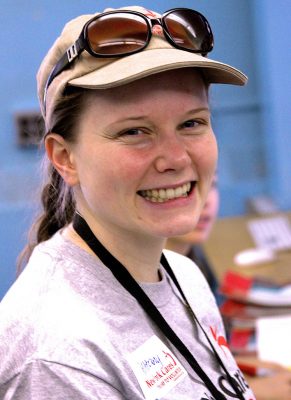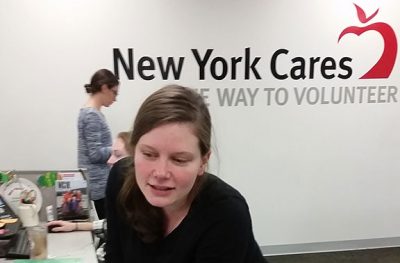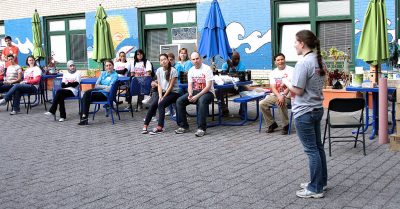In our special recurring 10 Questions series, the Neag School is catching up with students, alumni, faculty, and others throughout the year to give you a glimpse into their Neag School experience and their current career, research, or community activities.

Brittany (Perotti) Agne ’09 (CLAS), ’11 MA, a former Husky Sport volunteer who earned a master’s degree with a concentration in sport management at the Neag School, today serves as director of children’s education programs at New York Cares, a New York City-based nonprofit focused on volunteer management whose staff plans 1,600 volunteer-led projects every month.
At what moment did you know that you wanted to work with New York Cares? It was honestly a series of fortuitous events that led me to New York Cares. I didn’t know much about the organization before I started working for it in 2011, but I did know by that time (thanks to Husky Sport) that I wanted to go into the nonprofit side of sports-based youth development work as an ultimate career goal. The position that was posted online was almost identical to my responsibilities with Husky Sport, including volunteer management and working with kids to promote positive and healthy behaviors through sports and nutrition programs. It felt like it was a position that was made for me.
What made you choose to work in the Children’s Education Programs department of New York Cares? When I first started, the Children’s Education Programs department didn’t exist. Instead, the two teams that comprise the department today were part of Community Programs and Education Programs. I was part of the Children’s Recreation team, housed under Community Programs, because the perception was that sports was an “additional” component to a child’s education.
Thanks in large part to movements within youth development (and, honestly, the Let’s Move campaign from [first lady] Michelle Obama), I think people have come around to the idea that physical activity is a key component to a child’s academic success. New York Cares made the formal change in November 2015 by creating the Children’s Education Programs department, and that allowed all of the people working on kids’ programs to be one team tackling the multifaceted issue of student achievement in New York City. Now, we have people working on arts, nutrition, and sports programs alongside people working on STEM, reading, and other literacy-based programs. It makes much more sense and allows us to have a deeper connection with our community partners.
What are the types of education programs offered to children through New York Cares? It ranges from your traditional academic programs, like homework help, reading and math support, and the like to opportunities such as coding, Lego Robotics, martial arts, yoga, photography, dance, field trips, and culinary arts. We try as much as possible to customize content to the kids with the understanding that each community and every student is unique in their needs and desires.
How have you been able to integrate your background in sport management into what you are doing now? There are a few ways, particularly around the corporate social responsibility piece of Dr. Laura Burton’s sport management class [at the Neag School]. We spent time [in that class] talking about how people can and should encourage their [employers] to take on a particular cause in their community. New York Cares is largely funded by companies looking to do just that, as this has become more of an expectation of employees, with millennials continuing to enter the workforce. … Other classes, like marketing, also feel transferrable to what we do.
Perhaps the clearest connection for me, though, is Dr. Jennie McGarry’s work with Husky Sport and the service learning class, as well as discussions around issues in sport that shed light on income and racial inequality. Seeing firsthand the Hartford Public Schools system in action allowed me to have some sense of the New York City Public Schools system, and it was great to have that classroom-based experience before coming into the NYC education world.

How is New York Cares making a difference for New York City youth? I feel the impact is twofold, and one may be more obvious than the other. First, we are providing supplemental instruction for kids who are below grade level in math and reading performance or whose school is underfunded and cannot provide recess/physical education as frequently as mandated by the city. For kids in shelters, it may provide a safe space for them to develop with peers, where there is structure and purpose to what they’re doing, even if it’s simply sitting down and reading a book with a volunteer for 30 minutes or going ice-skating for the first time in Bryant Park during the holidays. It teaches them how to navigate their fears and their city and provides some consistency in their schedules.
The second major impact is through providing the adult support for children, giving them specialized attention that they may not otherwise receive during school or out-of-school time. There have been multiple studies on positive youth development that touch upon this idea of a caring adult role model and building that relationship as being critical to the success of programs. It’s the idea behind Big Brothers Big Sisters and other national-level branches of volunteering.
But I would be remiss to ignore the impact that the kids have on the volunteers, and that is that kids see the world with a totally different perspective and make you realize what’s really important. I think they have a ton of lessons to teach our volunteers and can open their eyes to issues that people face in the city.
When did you discover your passion for volunteer work? I’ve spent much of my life doing community service and was a member of National Honor Society in high school, which had a community service requirement, and I absolutely love working with kids. So when I got to college, I spent a little time doing tutoring at an elementary school in Willimantic [Conn.] when it could fit into my schedule.
In my junior year, I heard about Husky Sport and was curious about getting involved. It didn’t fit into my schedule until senior year, but that first semester of service learning was amazing. At that point, I was hooked on working in the nonprofit world and stayed at UConn to do my master’s program in sport management as a graduate assistant for Husky Sport. I especially loved that the focus was on the sociological aspect of sport, not just on how to make it from a business perspective, and got you thinking about the power companies have to affect change in their communities.
“We value every hour people give of their time, and if it’s just once a year that people can volunteer for one hour, that’s still meaningful. You still have the opportunity to make a connection with someone whom you may never have had the chance to meet.”
What would like the public to know about New York Cares as a whole? New York Cares is so much more than our Coat Drive (which many people know us for, if they’ve heard of us) and Winter Wishes programs. Yes, these are critical services, but if you’re looking for a way to truly know your city — or even if you’re just visiting and want to get some real New York experiences — volunteering is an easy way to do it.
We started (almost) 30 years ago when a group of friends came together and tried to find ways to volunteer, but struggled due to the lack of flexibility that people found when looking to get involved. Once people create an account with us, they can quickly see how we try to adapt our model to their busy schedules. Orientations are scheduled throughout the city at all times of day, and are also available online. Projects range from working in food pantries and senior centers, to animal shelters, parks, gardens, shelters, and schools. We value every hour people give of their time, and if it’s just once a year that people can volunteer for one hour, that’s still meaningful. You still have the opportunity to make a connection with someone whom you may never have had the chance to meet.
We’ve had people from all over the world come to us because they’re in New York for a week and want to see what life is like for people throughout the city, so it’s not limited to residents of the city if you want to get involved. We engage companies in customized service opportunities and are an integral part of disaster response, so there are a multitude of options for anyone looking to volunteer. We run more than 1,000 opportunities each month and engage more than 64,000 volunteers each year in service.
What have been some of the most rewarding moments at your job? Any time I am able to get to a program to spend time with the kids and volunteers is a great reminder of the significance of our work. We hear things like ‘This is the best day ever!’ from kids when we take them on trips or have volunteers in their classroom. Even though there can be days that are difficult, remembering that there is a person on the other side who is being impacted by your decisions puts it all into perspective. And the thank-you notes that the kids send to us are still hanging up in my office. They just have this enthusiasm for life and meeting new people that makes it all worth it.
In my work, I get to see the best side of New Yorkers, who are stereotyped as cynical and uncaring, but it’s really not the case. People are busy, stressed, and on the go 24/7 — that’s true — but they also find ways to get involved with their communities as a way to get to know their neighbors better or because they feel it’s the right thing to do. The motivation of kindness drives people to give even in the most difficult situations. It bridges the gap in socioeconomic status and allows the recipients of service to be empowered to also teach the volunteers.

What are some challenging moments you’ve had while working at New York Cares? The biggest challenge had to be Superstorm Sandy. Our office is in the Financial District, which had storm surges (we are right near Battery Park and the Battery Park Tunnel, which was completely underwater), so we were doing work remotely across the tri-state area. It was a true test of our systems in terms of keeping in touch with co-workers, as well as volunteers and partners.
A week after the storm hit, we were able to get back into our office because the subways finally reopened. We had 16-18 hour days from Oct. 29, 2012, until December of that year. Partners would call us at all hours, and we would post projects for people to volunteer at food distribution sites, as well as canvassing housing complexes to ensure that residents were safe and able to get their medicines, especially the elderly and those unable to take stairs.
Four years later, I can still remember it like it was yesterday, but it is a powerful reminder of what people deal with in the wake of disaster. For people in the flood zones, they’re still working to get back what was lost.
What were some of your favorite moments at UConn? As an undergrad, I worked for The Daily Campus as a sports beat writer and covered the women’s basketball teams in 2007-08 and 2008-09. We got to travel to the women’s tournaments, and I got the chance to see the best women’s basketball program courtside. That experience also taught me that I didn’t want to pursue a career in sports journalism, which was my original plan when I entered college, but it gave me a greater appreciation for the work that journalists do and the value of having trained journalists in a world of blogs and social media. I also loved Oozeball and the concerts that SUBOG put together.
Of course, my time with Husky Sport is also high up there with my favorite memories, particularly spending time in Ms. Vargas’ bilingual 3rd-grade class at Wish [school in Hartford], reading with her students and seeing how excited they were for nonfiction work, and Ms. Ziplow’s 6th-grade class, discussing current events.
What are your favorite things about New York City? There is such a diverse group of people that you interact with on a daily basis, regardless of where you go in the city, so there are times when you feel like you’ve stepped into another country. It gives a real sense of appreciation for the cultures of the people in that particular neighborhood. There’s also always something to do, and if you’re creative enough, you can find many things that are free to the public. With work, I get the chance to explore places a bit more with field trips and projects throughout the city.
Learn more about New York Cares at newyorkcares.org. Read other installments of the 10 Questions series here.


